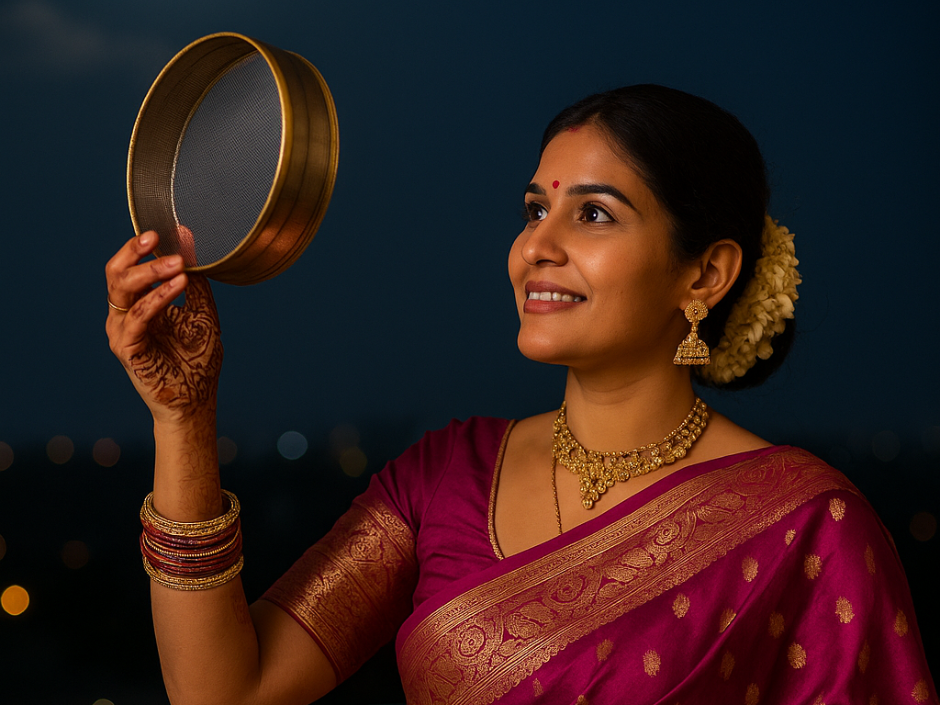Love Across Time Zones: How Karva Chauth Shines Abroad
- arjunveersingh
- Oct 10
- 3 min read

If there’s one day in the Indian festive calendar that blends romance, tradition, and a touch of dramatic flair, it’s Karva Chauth.Yes — the day when love (and hunger) are both tested to divine levels.
What is Karva Chauth, Really?
Traditionally observed by married Hindu women, Karva Chauth falls on the fourth day after the full moon in the month of Kartik (usually October–November).The ritual is simple in theory, complex in practice — a day-long fast without food or even water until the moon rises, all for the long life and well-being of one’s husband.
But over the years, the festival has transformed into something bigger, more inclusive, and yes — much more glamorous.Because today, Karva Chauth isn’t just about “fasting for love.”It’s about celebrating commitment, connection, and community — sometimes across continents.
The Classic Celebration
Back in India, Karva Chauth mornings begin with an early sargi — a pre-dawn meal prepared lovingly by mothers-in-law.Then comes the dressing up part — intricate mehendi designs, bright lehengas and sarees, and jewelry that could make a Bollywood costume designer nod in approval.
Women gather together for pujas, swap stories, and secretly check whose mehendi came out the darkest (we all know what that means 😉).And then, as the day stretches on, everyone keeps one eye on the clock and the other on the sky — waiting for the moon, the hero of the night.
When it finally appears (usually fashionably late), women look at it through a sieve, then turn to their husbands, breaking their fast with water and sweets — a scene so cinematic it could belong in Kabhi Khushi Kabhie Gham.
Karva Chauth, The US Edition
Now imagine celebrating Karva Chauth in New Jersey, San Francisco, or Dallas — where the moon follows Pacific Time and the family group chat is operating on India Standard Time.
Here’s how the desi diaspora does it:
Virtual Sargi Parties: Forget handwritten recipes — now, it’s all about FaceTiming your mom at 4 AM for a live tutorial on how to assemble the perfect thali.
Community Puja Zooms: Apartment clubhouses, temples, and even neighborhood parks in places like Edison or Fremont host group pujas. (Yes, even the local Starbucks patio has seen some impromptu moon gazing.)
Desi Husbands’ Dilemma: In the US, many men now fast alongside their wives — a sweet, equal-partner gesture that’s both romantic and practical (you can’t really order DoorDash when your spouse is fasting).
The Time Zone Trick: The moonrise is late in the US — sometimes around 9 PM or even later. So, women on FaceTime with family back in India often get play-by-play updates: “It’s out in Delhi! It’s out in Mumbai! Wait… where’s it in New York?”
And of course, no American Karva Chauth is complete without a Target candle, a borrowed sieve, and that one curious neighbor asking, “So, wait — you can’t even drink water?”
Love, Laughter, and a Little Lunar Drama
While tradition remains at the heart of Karva Chauth, modern couples have redefined its meaning.Many now treat it as a mutual celebration of love — not just one partner fasting for the other.And whether it’s a romantic dinner post-moonrise in Delhi or a late-night chai in California, the sentiment stays the same:It’s about devotion, gratitude, and shared strength — one moonrise at a time.
Final Thoughts
Karva Chauth today is more than a ritual; it’s a celebration of connection in a disconnected world.It’s for those who believe that love, in all its forms, deserves a little ceremony — whether you’re under the Delhi sky or a Seattle drizzle.
Because at its core, Karva Chauth is not just about seeing the moon —It’s about seeing each other, through every season, every fast, and every FaceTime lag.